What are the Best Footings for a Deck?

Choosing the right footing for your deck is an important step in your project. The footing forms the base of which your entire project is built on. Making sure to have a strong and reliable foundation will ensure the safety and longevity of your deck. Below we will go over the different types footings that may be used and share some advantages to each.
The Causes of Foundation Failure
The most common type of footing failure is often not caused by the footing itself. Most issues arise from how the footing interacts with the soil and changing soil conditions. Sinking/settling soils and frost heave are the primary concern when dealing with proper footings for a deck. Another factor is exposure to water and premature deterioration related to corrosion or rot of specific foundation types and components.
4 Different Types of Deck Footings
Deck Blocks - Yes or No?
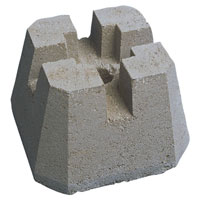
Deck blocks are a product often found at building centers like Home Depot. They are an appealing choice because of their low cost. However there are some major issue with using them for a deck. Deck blocks, although their name may be misleading, are almost never a good option. In any kind of soft soil they will sink over time - compromising the structure above. They will settle into any soil that is not fully compacted, especially black dirt, or clay. Deck blocks are also subject to the effects frost heave as they are almost always installed on grade. A deck block is not able to meet engineering requirements on most deck designs, and its bearing capacity is an unknown factor. This makes it an unreliable, and also unsafe option for almost all deck projects.
More often than not, deck blocks will not even meet local building codes without additional footing being constructed beneath them, so remember to consult your local authority before building. Deck blocks may be suitable for very small projects, that are required to be portable, temporary, or be very low to the ground and not be used for regular occupancy - like a base frame for a moveable light duty shed.
Advantages
Affordable, easy to install
Disadvantages
Not very strong, will settle and sink over time, can frost heave
Post In Concrete Pier
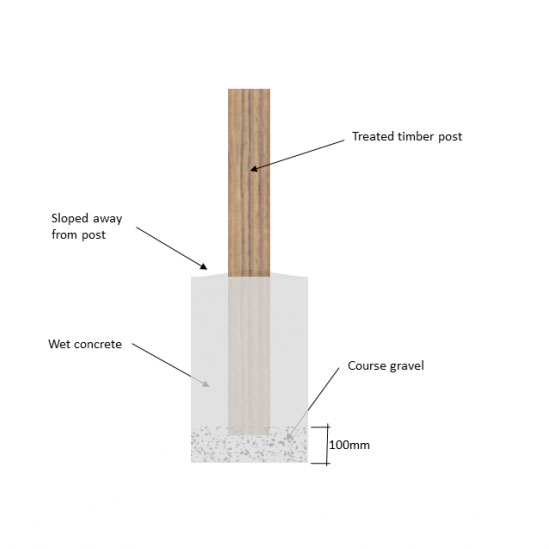
A more common solution for decks is to insert a pressure treated post into the ground and surround it with concrete. The post or pier must extend below the frost line to be effective.This design is still affordable does add some benefits over deck blocks. The primary benefit is that it is now properly situated below the frost line when done correctly and will prevent frost heave.
There are some issue with design however. While inserting the post into the concrete save time and money it creates a few new areas of problems. The first being that the post will now be subject to ground water, and will be prone to premature rotting. This can be mitigated by ensuring a sealed waterproof membrane is wrapped around the underground/encased post. A common pitfall of this design is an uneven or incorrectly sized concrete pier. Without proper engineering and size, the pier may fail to function , much better than a deck block. A misshapen pier can even worsen frost heave. One solution is to use a sono-tube and level to ensure properly structured concrete. The last issue come from a lack of maintainability. The post is underground and cannot easily be removed or replaced. There is no possibility or reusing the posts for future repairs.
The next method attempts to solve some of the pitfalls of this design.
Advantages
Low cost, easy to install, improved frost resistance
Disadvantages
Not the strongest, will rot prematurely
Concrete Pier with Base
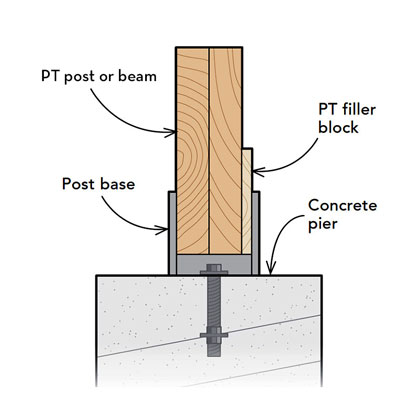
In order to address some of the issues with post rot, and repair-ability. A better design is to use a concrete pier, made with a sono-tube, and install a properly engineered post bracket to the cured concrete pier. The advantages to this are that the post base separates the pier from the concrete, decoupling the foundation from the structure. This protects it from rot and allows for the structure to be rebuilt without taking out the concrete piers.
The main disadvantage of this solution, is that it is time consuming, costly, and inconsistent. Most decks are built on piers built with little to no understanding of the native soil conditions. As such it is common to find undersized piers, with too shallow a depth. This can result in teh footing sinking and ultimately damage the structure supported by the pier. If done correctly the concrete pier is labor intensive and slow, resulting in piles of displaced soil to remove, regrading, weather delays, and cure time. A proper pier design can even be as costly as other more advanced solutions such as helical screw piles.
Advantages
Strong lateral support, will not rot prematurely, good frost resistance
Disadvantages
Labor intensive, more costly, requires a lot of time and cleanup
Helical Screw Piles
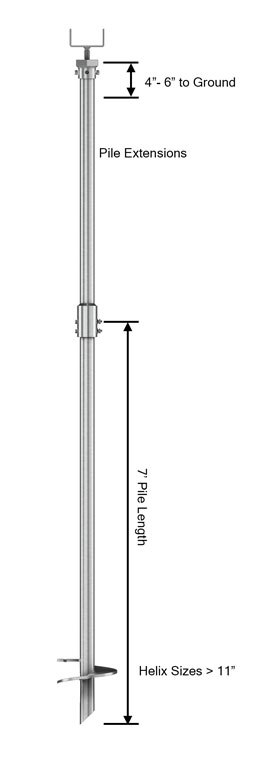
The most reliable foundation for a deck is helical screw piles. As a manufactured product, they have unparalleled consistency when it comes to strength - unlike concrete which depends on mix, temperature, and correct installation. Helical piles also offer the ability to reach greater depth with ease, and high bearing capacity.
One huge advantage to helical piles is the ability to calculate a near exact load capacity for the pile during installation. Regardless of whether the pile is being installed in clay or sand soil, the torque to correlation factor (Kt) for each shaft size, is multiplied by the effective installation torque (T), resulting in the ultimate capacity for each pile. The standard equation for ultimate capacity is Kt * T. Using systems such as differential pressure or advanced electronics to measure torque, a specific bearing capacity can be determined for every pile installed.
Are all helical piles created equal?
The short answer is no. Various factors effect the quality, and reliability of a helical pile. Even the shape of the helix plays a role in how it will perform. Its important to choose a pile that is built with quality standards and high strength materials. While some smaller piles are available at home hardware stores. Its important to note that there are significant limitations to these piles. Due to the small size and the thin metal, such piles cannot be installed with machinery or to high torques, and are often installed by hand. This means that the pile is rarely installed to an acceptable torque, or depth to prevent the small helix from failing under loads. These piles usually have no coupling between the initial pile and any extensions which means they cant be removed or repositioned, and there is a high chance of disconnection due to ground movement. A better option for small projects would be 1-7/8 inch diameter helical piles from GoliathTech, featuring a minimum 7ft length, high grade 60 KSI steel, bolted connections and helix sizes of 11 inches that are made with fully welded 1/2 steel construction.
For more information about helix sizes visit Helix Sizes Explained.
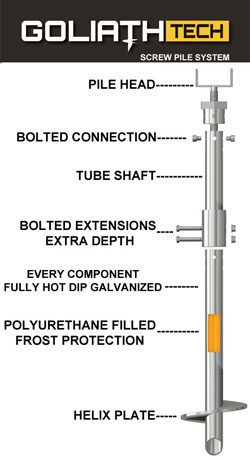
Another consideration is frost resistance and resistance to corrosion. Many piles offer no additional protection from frost or corrosion. These piles are called black steel or weldable piles. Often these piles are not acceptable to resist corrosion. A solution for this is often to install larger diameter, thicker walled piles to allow for the corrosion to take longer to compromise a structure. This is allows more time before the pile fails due to corrosion. In addition, there is no extra frost protection on any black steel piles.
To deal with corrosion, a solid thick galvanization is required. GoliathTech offers high quality galvanized steel piles that resist corrosion. They carry a 30 year guarantee but often times will last a lifetime. The GoliathTech galvanized piles also come with spray foam insulation inside the pile to prevent cold air and water from penetrating the pile tube down to the helix, which resists any frost heave even in minimum depth installations.
Need Help Choosing the Right Footing for Your Deck?
At 4Rest Decks and Piles, we specialize in providing expert advice and top-quality footing solutions. Whether you're starting a DIY project or planning a professional installation, our team is here to guide you.Contact us today to get personalized recommendations for your deck project and ensure a safe, durable foundation!
Advantages
Strongest foundation option, galvanized piles will not corrode, will not frost-heave, calculated load capacities, extremely long lifespan, includes custom mounting bases
Disadvantages
More expensive option, not DIY friendly, can not be installed into shallow bedrock

